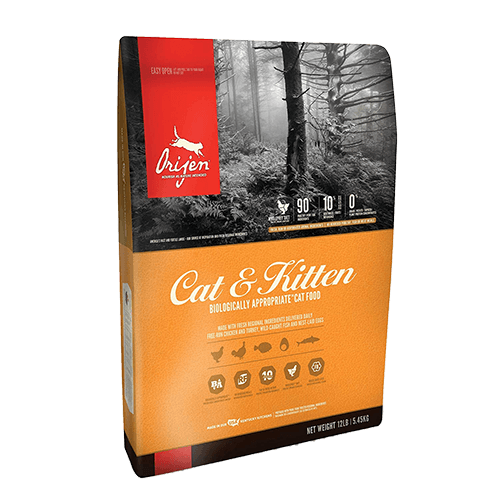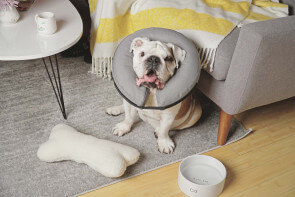
The 6 Best Cat Food Brands
We researched 50 brands of dry cat food and canned cat food to determine which is the healthiest for your cat. Orijen – Cat and Kitten grain-free dry cat food is unparalleled in high-quality ingredients. Each of Orijen’s recipes feature whole meats that your cat would eat in nature. The best canned food is unquestionably Ziwi Peak, made by a New Zealand company that packs more meat and fish into its products than any other cat food we analyzed.
Our Top Choices
We researched 50 brands of dry cat food and canned cat food to determine which is the healthiest for your cat. Orijen – Cat and Kitten grain-free dry cat food is unparalleled in high-quality ingredients. Each of Orijen’s recipes feature whole meats that your cat would eat in nature. The best canned food is unquestionably Ziwi Peak, made by a New Zealand company that packs more meat and fish into its products than any other cat food we analyzed.
Table of contents
The 6 best cat food brands we found
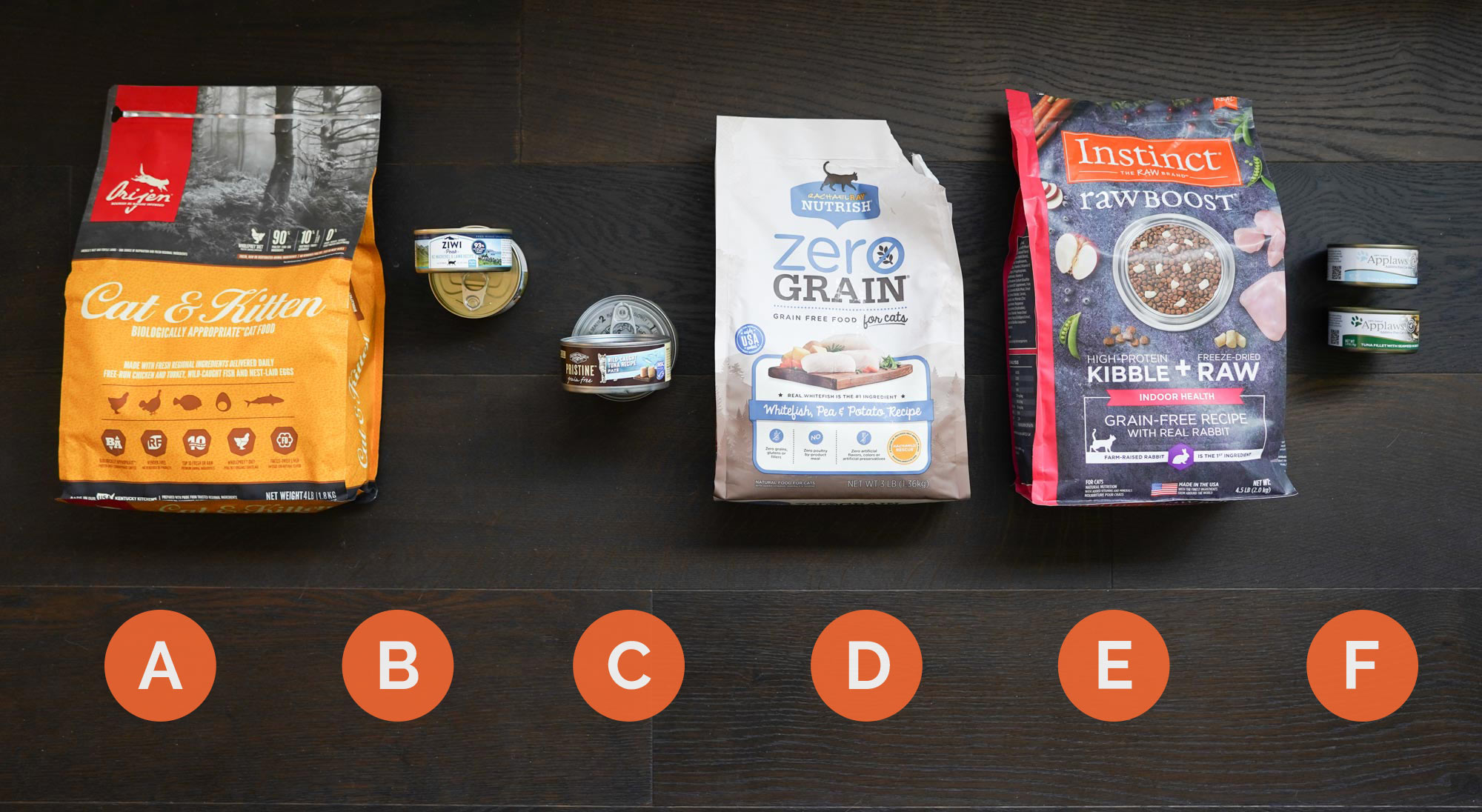
1. Best dry food: Orijen – Cat & Kitten

Our recommendations are based on research and the analysis of fifty products that can be purchased at grocery stores, pet supply stores, supermarkets and online. We’ve consulted veterinarians and pet food nutrition experts for their opinions about what criteria cat food should meet to be considered exceptional.
In our review of dog foods, we recommended Orijen – Original as the best grain-free dry food. We now recommend Orijen – Cat & Kitten as the best dry food for cats. All Orijen products are biologically appropriate, which translates to grain-free, high in protein and low in carbs. Orijen is a Canadian company that takes pride in using whole meats and fish in their foods. (Recently, Orijen began manufacturing in Kentucky as well.)
The ingredient list for the Cat & Kitten formula is impressive. The first ten ingredients are deboned chicken and deboned turkey, whole eggs, whole fish and whole chicken and turkey organs, such as heart and liver. Because so much moisture is lost during processing, and the whole meats and fish lose 75 percent of their weight, Orijen makes up for the loss by adding dehydrated meats and fish. Other pet food companies we analyzed add filler, such as rice or potatoes, to compensate for the loss in weight.
The added greens are also unique. Mustard greens, collard greens, kale and spinach are often called “power greens,” nutrient-dense and loaded with Vitamins A and C.
There are several legumes in the mixture — pinto, lentils and peas — these are controversial ingredients in cat food, since cats wouldn’t eat them in the wild. However, legumes are considered to be a healthy carbohydrate: High in fiber and protein, low in fat and vitamin rich. Protein-to-fat ratio is an appropriate two-to-one with 44 percent protein and 22 percent fat.
Orijen has several other recipes that are marketed as “Whole Prey” to cat owners who want to feed their cat a more wild diet. The Tundra recipe, for example, has goat and wild boar, and the Regional Red has angus beef, wild boar, goat and Yorkshire pork. These recipes seem a bit rich, but surprisingly, they all have the same appropriate protein-to-fat ratio.
Champion Pet Foods manufactures Orijen and Acana, another high-end dry cat food. Acana’s four recipes also feature locally sourced meats, fish and game meats. Their website states that Acana’s dry foods contain 75 percent meat and fish and are biologically appropriate. There is certainly a lot of meat and meat meals in the Acana recipes, but with the added filler of several legumes, which cats don’t eat in the wild, we’re not recommending Acana. It’s a very good dry cat food, but Orijen is better.
All Orijen products are more expensive than other dry foods, but no other dry cat food we found can beat the amount of quality meat that Orijen puts into its food.
Key takeaways:
- Orijen combines fresh and raw meats and fish with dehydrated for a dry food that is unparalleled in the amount of meat as primary and secondary ingredients.
- With 90 percent meat, other ingredients are vitamin-packed power greens and several legumes as healthy carbohydrates.
- Orijen has several other high-protein recipes with rich and lean wild game meats.
2. Best canned food: Ziwi Peak

New Zealand-based Ziwi Peak is one of the few pet food companies that only uses locally sourced and free-range meats and poultry. Ziwi Peak has developed their cat food recipes specifically for a cat’s biological needs: rich with lots of meat and very low in carbohydrates.
Understanding that not every cat’s digestive system can tolerate chicken or beef, Ziwi Peak also makes recipes with game meats (like rabbit and venison) which, for some cats, are more digestible. The company also has a few recipes with mackerel and hoki, a New Zealand white fish.
All of the Ziwi Peak foods are excellent and are packed with 92 percent meat (or meat and fish). There are a few complaints online that Ziwi Peak used to boast 93 percent, but we think that’s quibbling. One glance at the ingredients list, and you’ll see why Ziwi Peak is the best canned cat food you can buy.
The recipe we recommend is mackerel and lamb. The primary ingredients are mackerel, water (for processing) and lamb, including lamb organs and chickpeas (which are actually pretty far down on the list). Essential minerals and vitamins are added, including taurine, but there are no grains, starches, preservatives or additives that have known harmful effects.
We should also note that Ziwi Peak is one of the few companies that adds green-lipped mussels to their pet foods. Green-lipped mussels are native to New Zealand and have proven anti-inflammatory properties for humans and pets.
The mackerel and lamb recipe has a two-to-one protein-to-fat ratio with 40 percent protein and 20 percent fat. The rabbit and lamb recipe is substantially higher in protein (50 percent) and not surprisingly, since rabbit is a lean meat, only 15 percent fat.
A drawback for some people might be that all Ziwi Peak products are expensive, running about $3.50 per 6.5 ounce can with a recommended feeding portion of one can per day. Ziwi Peak can be purchased online by the case, and it’s definitely cheaper per can than purchasing a couple cans at a time. The quality of the ingredients is undeniable, however, and from our analysis, we believe improving your cat’s diet is worth this canned food’s higher price.
Key takeaways:
- All of Ziwi Peak’s cat foods contain 92 percent locally sourced meats and fish.
- Their recipes were designed specifically for a cat’s biological needs and are high in protein, moderate-to-low fat and very low in carbohydrates.
- A few recipes use game meats, like venison and rabbit, which for some cats are easier to digest.
- Ziwi Peak products are more expensive than other brands, but the quality of the ingredients is worth the cost.
3. Nature’s Variety – Instinct Raw Boost

Instinct Raw Boost combines a grain-free kibble with freeze-dried raw chicken, duck or rabbit, depending on the recipe. The chicken recipe and duck recipe are recommended for outdoor/indoor cats, and because rabbit is lower in fat, the rabbit recipe is recommended for indoor cats, who are less active. There’s also a weight-control formula, but it’s only 1 percent lower in fat than the rabbit recipe (14 percent).
Both the duck and rabbit recipes start out with whole meat, followed by four meat meals, which is exceptional. Like many other kibbles, one of the primary ingredients is peas, tapioca and/or chickpeas. But Instinct throws in the freeze-dried meat cubes as a bonus, boosting up the protein and providing another excellent source of raw meat.
Also added to the ingredients are small amounts of freeze-dried rabbit heart, lung and kidney, so it’s not surprising that Instinct Raw Boost has one of the higher percentages of protein (43 percent) among the dry foods we analyzed.
4. Rachel Ray Nutrish – Zero Grain

Rachel Ray certainly isn’t the first chef to create a line of pet foods inspired by chef recipes. We admit we were skeptical, until we took a closer look. Rachel Ray Nutrish has three varieties on the market: the original brand, called Nutrish, and two specialty brands, Nutrish – Peak and Nutrish – Zero Grain. We examined all three, and Zero Grain has a lot more meat and a lot less filler than Nutrish and Peak.
There are two recipes for Zero Grain: chicken and potato or whitefish and potato. (Maybe somebody needs to tell Rachel to lay off the carbs.) However, the whitefish and potato recipe is actually very good. Yes, it has potato, but it’s not in the primary ingredients. The first four ingredients are whitefish, salmon meal, menhaden fish meal and turkey meal. So, there’s more protein than filler in this formula.
Zero Grain has an appropriate two-to-one protein-to-fat ratio, but it is slightly lower in both than other dry foods we analyzed (38 percent protein and 17 percent fat). Nutrish – Zero Grain is modestly priced, and for a food that doesn’t have by-products, it’s a good value.
5. Castor & Pollux – Pristine
The Pristine line of Castor & Pollux’s excellent pet foods promises that their meats are harvested from animals who lived happy, healthy, free-roaming lives, and their fish are wild-caught.
There’s little doubt that the quality of the ingredients in the grain-free Pristine recipes are top-notch. But of the four varieties, we recommend the wild-caught tuna. (It’s also the most popular of the Pristine line with cat owners.) The other three products have dried egg and organic peas in their primary ingredients. The tuna recipe also has the egg and peas, but the big difference is that organic chicken and chicken liver are in the top five.
With these meat additions, the Pristine tuna has an above average three-to-one protein-to-fat ratio with protein at 40 percent and fat at a low 13 percent, which makes this canned food great for indoor cats.
6. Applaws
MPM (Making Pet Food Matter) is a fairly new pet food company. Incorporated in 2002 and based in the United Kingdom, MPM produces and distributes Applaws around the world. The company is very strict about where and from whom they source meats, and you can tell with one look at their high-end product that they use human-grade meats and fish.
There are seven varieties of canned food, each with three or four ingredients; for example, tuna, seaweed, fish broth and rice or chicken breast with cheese. Applaws sells the same food in pouches, which have windows, and you can see for yourself just how appetizing they are.
Each recipe is high in protein and very low in fat; in fact, they’re too low in fat for a healthy cat. Applaws knows they’ve made an exceptional food, but because of the very low fat, they cannot recommend it as a stand-alone meal. It’s very clearly stated on the cans, pouches and website that their food is supplemental and will not provide all the necessary daily nutrients.
However, if you’re looking to add a tasty topper to your cat’s regular (and hopefully, balanced nutritionally) food, then consider Applaws.
Other brands we don’t recommend
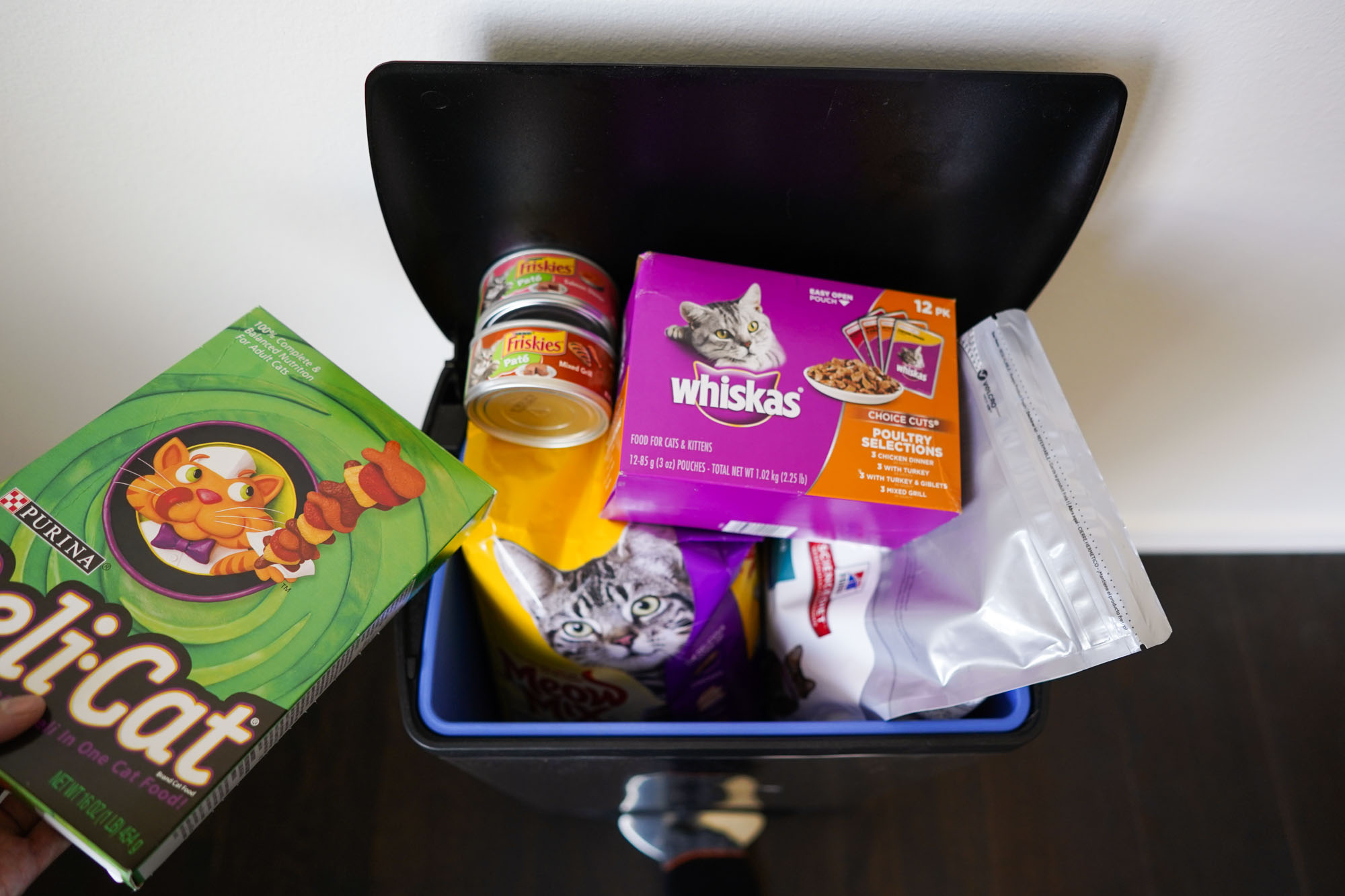
We understand that some pet foods are too expensive for people living on a limited budget. But we believe that there are products you can buy in any supermarket that are better made and healthier for your cat than those with familiar brand names. Your cat may enjoy the taste, but only because these low-grade foods have been treated with additives and flavor enhancers.
7. Meow Mix – Original (not recommended)
Meow Mix – Original is a long-time favorite that’s an example of what pet food should not be. Its number-one ingredient is ground yellow corn, which, as we’ve pointed out, has almost no nutritional benefits for cats. The second ingredient is corn gluten meal; again, more corn and empty calories. Chicken by-product meal provides the meat source. Other primary ingredients are beef tallow (fat) and “animal digest,” which is nothing more than the boiled down juices of some unidentified animal. It’s cheap, and there’s a reason for that.
8.Purina: Deli-Cat (not recommended)
Purina Deli-Cat is a popular dry food that’s another cheap brand you should avoid. As with many Purina products for both cats and dogs, ground yellow corn is the primary ingredient. As if soybean meal and corn gluten meal (ingredients two and three) weren’t bad enough, other primary ingredients are “meat and bone meal” and “animal fat.” Both of these ingredients are low-quality, and because the species of animal isn’t stated, the meat and fat could have been harvested from any animal? Lastly, two carcinogenic food colorings, Red 40 and Yellow 5, give this kibble its unnatural hues.
9. Purina: Friskies – Mixed Grill (not recommended)
Friskies is another popular brand with an array of canned foods labeled with appetizing names. Look at the label, and you’ll realize it’s junk food. For the mixed grill recipe, the first ingredient is meat by-products. So straight off, your cat will be nibbling on the carcass of an unidentified animal. The other primary ingredients are poultry by-products (could be any bird’s carcass), liver (could be any animal’s liver) and rice. Friskies is also one of the few products we examined that had carrageenan, which some say induces gastric inflammation.
10. Whiskas – Choice Cuts (not recommended)
Whiskas is one of the largest manufacturers of cat food, and we analyzed several of their products. They all had the same problem: water for processing is their number one — meaning, the heaviest — ingredient. In this variety pack, all four have chicken, unidentified meat by-products and wheat gluten. Whiskas adds an infinitesimal amount of beef or tuna to their basic chicken recipe. As long as the cat can detect it, Whiskas has followed the AAFCO rule about what defines “flavor.”
11. Hill’s Science Diet: Indoor (not recommended)
You might be surprised to see the much-hyped Hill’s Science Diet on this list. Hill’s has done a brilliant job at marketing. Their prescription diets are excellent and can only be purchased from a veterinarian. Their supermarket brand, however, is much lower quality. For this kibble, the first ingredient is chicken. It goes downhill from there. Whole grain wheat, corn gluten meal, wheat gluten and brewers rice pack this food with carbs. Way down on the list, a little chicken liver flavor is thrown in. Don’t be fooled by the advertising; the supermarket line is based on poor science.
What do cats need in their diet?
Cats are obligate carnivores, which means that they are sustained solely on the nutrients found in animal meat. Cats evolved as hunters and consumed prey animals that provide a high level of protein, low to medium level of fat, high moisture (from the meat itself) and very little to almost no carbohydrates. In fact, there is no known dietary carbohydrate requirement for a cat. The only grains a cat in the wild might eat would be the remnants in a prey animal’s digestive tract.
Indoor cats, however, do not get their daily necessary nutrients from prey. Their diet needs supplements of minerals, fatty acids and amino acids. Two amino acids — taurine and argenine — are vital to a cat’s overall health.
Argenine helps a cat’s body process ammonia that is created during digestion. Taurine is vital for development of a cat’s eyes, heart, muscles and immune system. Both amino acids are naturally occurring in prey meat. Many cat food companies add taurine to dry cat food to compensate for the lack of meat in the food. It’s essential, however, that a cat eats meat every day to get the amino acids he/she requires to live a long and healthy life.
Renowned veterinarian Dr. Karen Becker promotes a “biologically appropriate diet” to help your cat thrive. Your cat’s genetic makeup and internal workings are essentially the same as a wild carnivorous ancestor’s. A biologically appropriate (also called species appropriate) diet mimics a wild cat’s diet, which means high protein, high moisture, low fat and very low carbohydrates, all of which points to feeding your cat meat.
Dr. Becker also believes that many nutritional deficiencies and degenerative diseases in cats and dogs are directly linked to commercially processed pet foods. For decades, pet foods have been marketed as conveniences for pet owners. Many are cheaply made and loaded with corn (indigestible for both cats and dogs), soy, wheat gluten and other non-meat ingredients.
Cats are prone to potentially life-threatening illnesses resulting from carb overload. Indoor cats in particular are susceptible to obesity, type 2 diabetes, urinary tract issues and kidney disease. Several cat food manufacturers have upgraded their products. But many companies still make a product that provides little nutrition or benefit to your cat’s overall health.
How is cat food made?
Canned
The primary ingredients of canned cat food are fresh meat and meat by-products, which includes the cleaned carcass and internal organs of the slaughtered animal. The meat is frozen and either cut into chunks or ground. It is then steamed in water or broth, and the cooked meat is then combined with other ingredients, such as vegetables, grains, along with added vitamins and minerals. A starch or thickener is added to gel the mixture together. The mixture is packed into individual cans, vacuum-sealed and sterilized in a heating chamber.
Dry food
Fresh or frozen meat and meat by-products are combined with ground grains, fats, vitamins, minerals and meals derived from ground bone or ground dehydrated meat or meat by-products. This mixture, resembling bread dough, is forced through an extruder, which cooks and cuts it into shapes. The pieces are then oven-dried, cooled and sprayed with flavor enhancers and preservatives.
Freeze-dried
Cut raw meat is placed inside a vacuum chamber, which freezes the meat solid. The chamber’s temperature is gradually increased and pressurized. The meat’s frozen internal liquid converts to vapor and is extracted. Freeze-dried food may be fed as-is or rehydrated.
Dehydrated
Conversely, dehydration involves a heat process of removing moisture from meat. Low heat is slowly applied to the raw product until it is completely dried. Dehydrated foods must be rehydrated before feeding.
AAFCO standards for cat food
The Association of American Feed Control Officials (AAFCO) and the U.S. Food and Drug Administration (FDA) regulate pet food standards. The AAFCO is made up of scientists, veterinarians and animal nutritionists who have devised industry-wide standards for what ingredients can be used in manufacturing pet foods. For any pet food to be deemed certified by the AAFCO, ingredients must be:
- Species appropriate
- Proven safe
- Nutritionally adequate
AAFCO labeling rules
Although neither the AAFCO nor FDA can enforce truth in advertising, cat food manufacturers must follow the AAFCO’s rules for the precise wording on the product label of how much and what kind of meat is in the food.
95-percent rule: The named ingredient — for example, tuna or chicken — must weigh at least 95 percent of the total weight. If two ingredients are named on the label — tuna and chicken — then together they must weigh at least 95 percent of the total weight.
25-percent or “dinner” rule: Cat food labeled as “dinner” must contain at least 25 percent of the named ingredient in the total weight. Other words you’ll see on the label that fall under the 25-percent rule are “entree,” “platter” and “formula.” If a second ingredient is listed — like “Tuna and Chicken Dinner” — then the second ingredient must weigh at least 3 percent of the total weight.
3-percent or “with” rule: The AAFCO originally created this rule for pet foods that advertised a minor ingredient in the food. It’s been modified so the word “with” — as in “Cat Food With Tuna” — means that at least 3 percent of the total weight is actually tuna.
Flavor: “Tuna Flavor Cat Food” means that tuna is an ingredient, but it only needs to be detectable. Many cat-food companies use “digest,” which is a flavor enhancer made out of the liquid of boiled meats (usually poultry or beef), to be in accordance with this labeling rule.
Natural: “Natural” means ingredients made from animals, plants or minerals that have not been chemically processed except for standard preparation procedures. “100-percent natural” or “all-natural” means that there are no synthetic ingredients in the food.
Organic: The U.S. Department of Agriculture (USDA) has the same requirements for cat food as it does for food consumed by people. For ingredients to be labeled as organic, they must be produced without synthetic fertilizers, irradiation or genetic engineering. The USDA does not take an official position as to whether organic foods are healthier or more nutritious than non-organic foods.
AAFCO definitions of ingredients
The AAFCO is very specific about the proper naming of ingredients. The majority of pet food companies do not use ingredients intended for human consumption. When you read the label of canned or dry cat food, make sure that the meat or fish used is actually identified.
A major controversy in the pet-food industry is a manufacturer using what is known as 4-D — diseased, dying, down or dead — animal meat that is deemed by the FDA as unfit for human consumption. Although the FDA has “compliance guidelines” that forbid using 4-D meat as a potential health hazard, many veterinarians and pet nutritionists believe the FDA is unable to regulate all suppliers of meat for pet food.
So if a cat food label doesn’t state what species of animal was used to harvest its meat, you have no idea what you’re feeding your beloved tabby. The worst cat foods we analyzed listed only “animal” or a body part, such as liver, of an unidentified animal in the ingredients. We can’t surmise why, but we found more unidentified animal meat in cat food than we did when dog food review.
All ingredients are required to be listed in order by weight. Primary ingredients — those with the most weight — will be the first four or five listed. Meat or fish should always be the first ingredient. Water or broth is needed to cook the meat in canned food, so it will usually be the second or third ingredient.
The same rule applies to dry food before processing. Chicken could be listed as the first ingredient, but once that chicken’s been cooked and dehydrated, nearly 75 percent of its original weight is lost.
The following three AAFCO definitions apply to all meat processed in pet food.
Meat is defined as “the clean flesh of slaughtered mammals and is limited to muscle tissue attached to the skeleton by tendons with or without the accompanying and overlying fat and the portions of the skin, sinew, nerve and blood vessels which normally accompany the flesh.”
Meat by-products are rendered animal parts deemed not suitable for human consumption. They include internal organs, heads, feet, hair and unhatched eggs. Although by-products are not considered esthetically pleasing by many people, they are safe and nutritious for cats.
Meat meal and by-product meal are meat and meat by-products, including bone, from which fat and moisture have been removed. Bone meal is similar to meat and by-product meals, but it can include entire carcasses. Unlike meat and meat by-products, animals other than cattle, sheep and goats may be used without identification on the label.
How to choose the best cat food
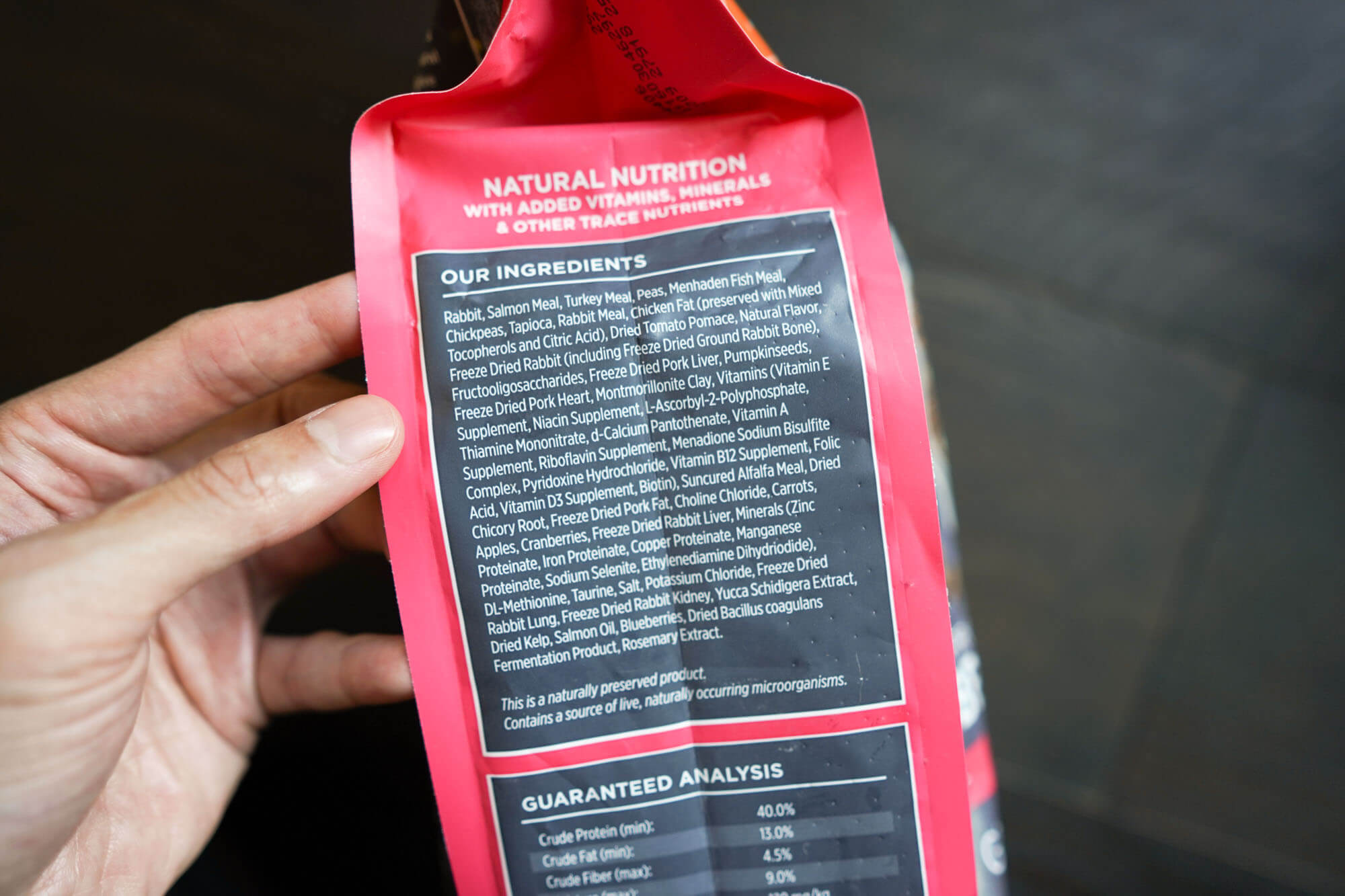
First, read the label. The FDA and AAFCO together enforce the required labeling of pet foods. All pet foods must be labeled with:
- Ingredients
- Manufacturer’s name and address
- Feeding directions
- Calorie statement
- Guaranteed analysis
- Nutritional adequacy statement
All manufacturers of cat food must comply with the FDA’s regulations to sell their product. As long as the manufacturer follows the rules for labeling, they are free to add virtually any ingredient to their cat food.
Guaranteed analysis
Guaranteed analysis lists the percentages of minimum crude protein and crude fat, moisture and maximum crude fiber. “Crude,” however, does not refer to the quality of the nutrient but to the method of estimating the quantity of the nutrient.
This is where it gets confusing. If you see 10-percent minimum crude protein listed on a can of wet cat food, it’s not the actual amount of protein. The only way to determine the nutritional value of a dry or wet cat food is to calculate what’s called the “dry matter basis.” At first glance, it may seem overly complex to figure out, but it’s quite easy.
Step 1: Subtract the percentage of moisture listed on the canned food’s label from 100. As an example, the label on the canned food lists moisture as 78 percent. Subtract 78 from 100, leaving you with 22 percent of dry matter.
Step 2: Divide the percentage of protein listed on the label — in our example, 10 percent — by the dry matter 22 percent, equaling .45.
Step 3: Multiply that result by 100, and this will now give you the actual percentage of protein in the canned food, which, in our example, is 45 percent.
Repeat the calculation with the percentage of fat listed on the label, and you’ll get an accurate representation of how much fat is in the food. The dry matter basis works for dry food as well. Compare them, and you’ll understand how much protein and fat each actually has.
Nutritional adequacy statement
Any cat food manufacturer that claims its product is “complete and balanced” must be labeled with the AAFCO nutritional adequacy statement. The food has been tested using AAFCO Feeding Trial Protocols under strict guidelines. Look for this statement on the packaging, usually near the ingredient list:
“…formulated to meet the nutritional levels established by the AAFCO Cat Food Nutrition Profiles for all life stages.”
If you don’t see the AAFCO’s nutritional adequacy statement, the product has not met the AAFCO’s stringent standards.
“Made in the USA”

By the Federal Trade Commission (FTC)’s definition, “made in the USA” means that all or virtually all of a product has been made in the U.S. The FTC is less strict, however, about pet foods. A manufacturer of cat food may indeed process its product in the U.S., but it may source lower-grade ingredients outside of the U.S.
The best you can do to ensure that the cat food you buy is made with U.S.-sourced ingredients is checking whether the company has taken the Association for Truth in Pet Food’s Pledge to Quality and Origin of Ingredients.
Ingredients to avoid
The following ingredients should not be in any cat food that you buy. Most will be found in cheaper brands as alternatives to higher-grade ingredients.
BHT or BHA: Chemical preservatives added to fats to prevent spoilage. Banned in most countries for potential links to cancer, these chemical preservatives are still added to certain cat foods in the U.S. and Canada.
Beef tallow: A low-cost fat that’s added as a flavor enhancer.
Carrageenan: A thickener used in cat food with a gravy. Some research shows that certain by-products of carrageenan could induce gastric inflammation in both humans and animals, though the debate is raging on what to do about the additive itself.
Corn syrup, fructose and sucrose: These sugars and other sweeteners are added to make lower-grade ingredients taste better.
Corn: Often found as the first ingredient in cheaper brands of dry cat food, corn has little nutritional benefit for cats and adds unnecessary sugar and carbohydrates to their diet.
Ethoxyquin: First created as a pesticide and a food preservative, ethoxyquin has been linked to cancer. It’s banned from human food, but it’s used in cat food as a preservative for fish and fish meal. A cat food manufacturer is not required to list ethoxyquin on the label if fish or fish meal was purchased from a supplier outside of the U.S.
Food dyes: Often used in cat kibble, Blue 2, Red 40 and Yellow 5 and 6 have been linked to cancer in test animals. The dyes are added to appeal to your eyes, not your cat’s digestive system.
Generic animal fat: If the animal fat isn’t identified on the label, you’ll have no idea from what species of animal the fat has been trimmed.
Sodium tripolyphosphate: This FDA-approved salt is used as a preservative in meats to retain moisture so they weigh more and appear to be fresher. In Europe, it is an allowed additive listed as E451. The National Institute for Occupational Safety and Health (a division of the CDC) suspects sodium tripolyphosphate may be a neurotoxin.
Wheat gluten: Added as a filler to replace higher-grade proteins. Like humans, some cats cannot process gluten and may suffer gastric distress when eating it.
What’s in the best cat food?
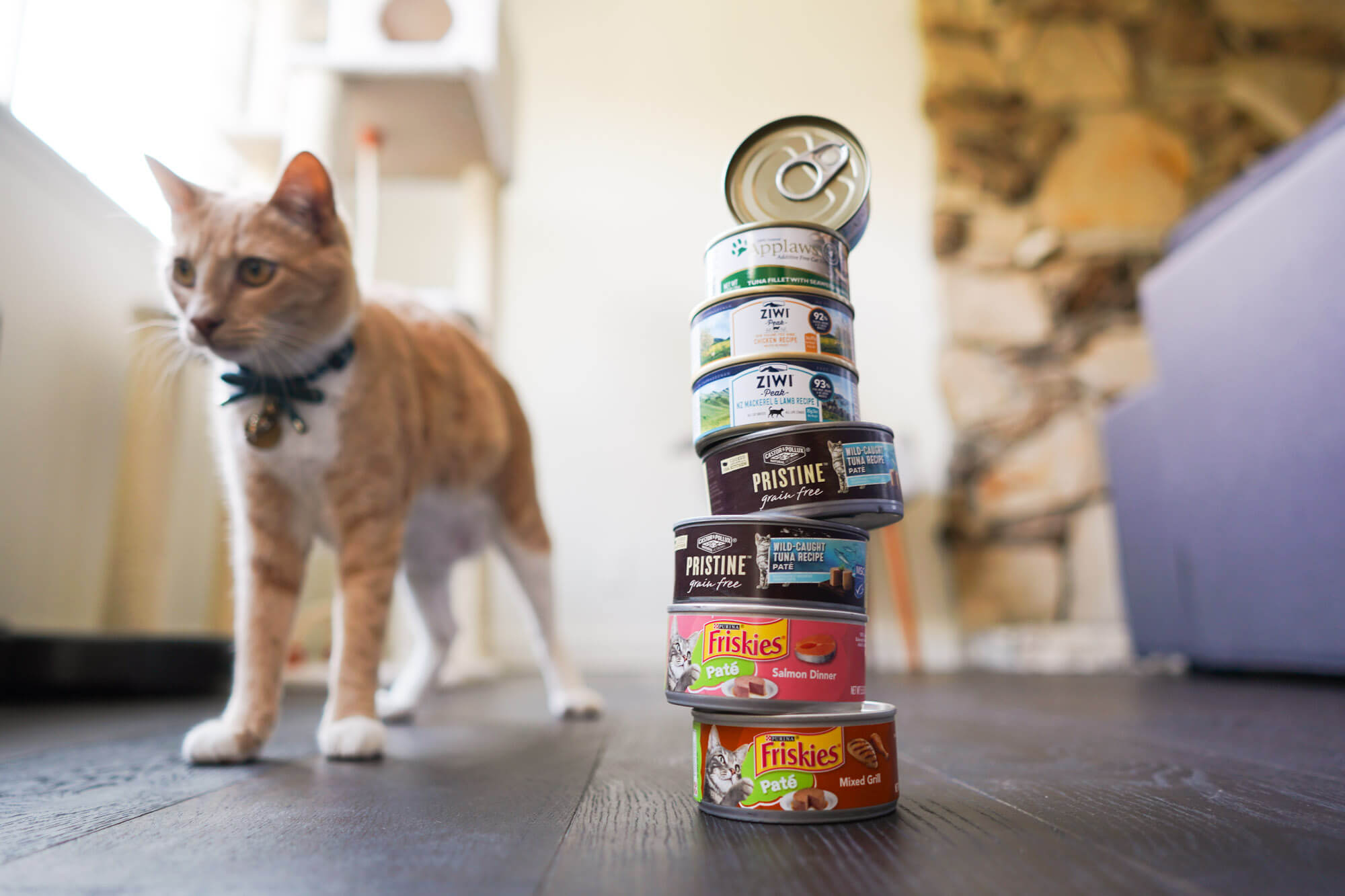
Canned
The primary ingredients are an identified whole meat: The first ingredient should be an identified whole meat. Water or broth for processing will be second. The third and fourth ingredients should also be other identified whole meats. If you see brown rice or corn or barley as the third or fourth ingredients, that’s too much filler and will add carbohydrates.
Whole unprocessed vegetables: The nutrients, vitamins and antioxidants of whole foods will survive processing better than ground vegetables. For example, “peas” are more nutritious than “pea flour.”
Limited carbohydrates: Don’t assume that if a food is grain-free that it has less carbohydrates. Many grain-free cat foods have starchy vegetables, like potatoes or sweet potatoes, which add unnecessary carbohydrates.
High protein, low fat, high moisture: The AAFCO recommends a minimum daily consumption of 30 percent protein and 9 percent fat for kittens, and 26 percent protein and 9 percent fat for adult cats. These guidelines are simply for a cat’s survival. For a healthy adult cat, pet nutritionists recommend approximately 40 percent protein and 20-25 percent fat. All of the canned foods we analyzed had 78 percent moisture.
AAFCO nutritional statement: Look for a statement on the can’s label that the food “provides complete and balanced nutrition for all life stages.”
Dry
The first three ingredients are an identified whole meat: If you see salmon listed first, that’s great. But remember that salmon loses up to 75 percent of its weight during processing. So to make up for that loss, the second and third ingredients should be other identified whole meats (or fish) or meat (or fish) meal.
Whole vegetables and limited whole grains: Whole vegetables and grains will retain more nutritional value than vegetable or grain flours during processing. Grains add carbohydrates, so look for dry foods that have grains lower on the list of ingredients.
Appropriate protein-to-fat ratio: Using the dry method basis, the best dry foods we analyzed averaged between 38-44 percent protein and 17-22 percent fat, which is considered appropriate for healthy adult cats.
AAFCO nutritional statement: “Provides complete and balanced nutrition for all life stages” should be on the food’s label.
The bottom line
Your cat’s age, weight and activity level will determine what’s the best cat food for him/her, and you should consult with your veterinarian if you’re considering switching foods. During our analysis of ingredients and nutritional statements of 50 dry and canned cat foods, we found many examples of products you should never feed your cat.
However, there were several stand-outs that upheld the standards of AAFCO’s regulations for “complete and balanced nutrition at all life stages.”
We recommend Orijen – Cat & Kitten as the best dry food. This biologically appropriate food is a high-protein smorgasbord of ten whole meats and fish, whole eggs and dehydrated meats. It’s more expensive than other dry foods, but it’s certainly one of the best you could feed your kitty.
Ziwi Peak is an excellent example of what all canned cat foods should be. Each can has 92 percent locally sourced meat and/or fish from New Zealand. Ziwi Peak also uses lower-fat game meats and New Zealand green-lipped mussels, a unique protein source that has proven anti-inflammatory properties. It’s also more expensive than other brands of wet cat food, but you will be feeding your cat the best.
More Reviews
Mac Sports - Heavy Duty
Healthy Paws
SmartCat - Ultimate Scratching Post
Litter-Robot 4 Review: Cat-Testing a $700 Litter Box
Litter-Robot 4
Armarkat - 72-inch Cat Tree & Condo
Cat Dancer
Shark - Apex
The 7 Best No-Pull Dog Harnesses
Auroth - Tactical Dog Harness
The Best Outdoor Security Camera Systems
Nest - Cam Outdoor
Shiny Pet
Safety 1st - Bamboo Gate
CatGuru - Heavy Duty Cat Litter Mat


